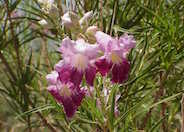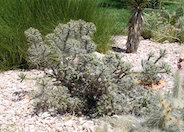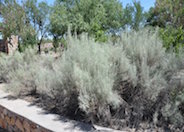
Common name:Desert Willow 'AZT Bi-Color'
Botanical name:Chilopsis linearis 'AZT Bi-Color'
Chilopsis linearis 'AZT Bi-Color' grows quickly to 30' x 15'. Glossy green leaves contrast nicely with the gray-white bark. Fragrant flowers appaear spring to fall and are unique among the Desert Willows with dark burgandy petals and pink throats. This tree will need some pruning to achieve and attractive single or multitrunked form. They provide excellent filtered shade for understory plantings. Consider planting where you need winter sun, as they are deciduous. -Arid Zone Trees

Common name:Diamond Cholla
Botanical name:Cylindropuntia ramosissima
Cactus can grow up to 3 feet tall and wide. Close up of the plant will display a diamond shaped pattern on the stem. Flowers are small and yellow-green to faded red.

Common name:Sand Sage
Botanical name:Artemisia filifolia
Provides softness and movement in the landscape. Fragrant, threadlike leaves and stems, airy evergreen shrub is covered wiht white hairs giving it a silvery cast. Flowers inconspicuous. Fast to 3' tall and wide. Native to western plans and southwest. Grows in rocky or sandy soils 1-8000'. Full sun and well drained soils. Will tolerate sandy and clay soils.

Common name:Eastern Redbud
Botanical name:Cercis canadensis texensis 'Oklahoma'
This small, deciduous tree with a rounded head is covered with small flowers of a rose pink color in the spring before the appearance of heart-shaped leaves. It can grow to 25' tall with an equal spread. It has a low branching habit with a rounded form. Leaves turn yellow green in the fall. Not as tolerant of drought of high pH as some other varieties of Redbud. Needs protection from the afternoon sun in the low desert.
| Designer: El Paso Desert Botantical Gard | El Paso Desert Botantical Gardens 24 |
Photographer: GardenSoft |
Soils and Compost:
Practice grass-cycling by leaving short grass clippings on lawns after mowing, so that nutrients and organic matter are returned to the soil.
Water Saving Tip:
Even during our hottest months we don't need to water daily.
Give your plants a chance to breathe.
Water late at night or in the early morning hours to avoid losses to wind and evaporation.
Integrated Pest Management:
Drip and other smart irrigation delivers water directly to roots, allowing no excess water for weeds.
